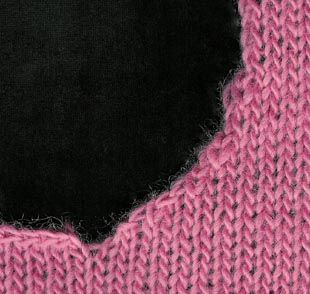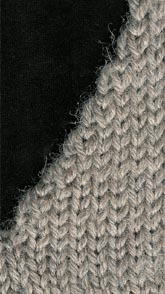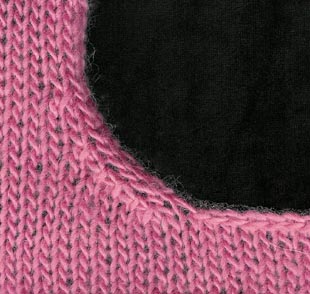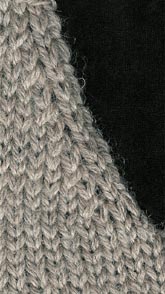| 13: Shaping the Neck
The neck is a very important part of a
garment, because it is near the face and is a focal point. When
someone looks at your face in conversation, or even when you look at
yourself in the mirror, the eye also takes in the neck area. A
well-shaped and perfectly worked neck wonít actually stop traffic,
but a thrown-together neck band or a carelessly finished neckline
will spoil the look of a garment.
The way the neck shapings are worked will make a huge difference
when picking up stitches for a neck band, or any other method you
choose to finish the neck.
The position of the shapings is the key to a good result. When poor
shaping makes it hard to decide where to put the stitches on the
pick-up row of a neck, then it will be difficult to work the neck so
that it will look good and sit well. If you work the neck shaping on
the edge stitches there will be no clear line to follow when picking
up stitches for the neck band. Holes in the pick up-row, stitches
crammed into the wrong positions and neck bands that stand out at
the side of the neck or pull in too tightly are usually the result
of messy shaping [pic 1,2].


1: (left) The shaping has been worked
on the edge stitches, and presents a problem when deciding where to
pick up stitches.
2: (right) A V neck worked in the same way shows the
same difficulty.
Work any shaping one or two stitches in from
the edge (see here). Then, you will have a smooth edge that makes
it easy to see where you should pick up the stitches [pic 3,4].


3: (left)
The shaping has been worked a couple of stitches in from the edge
and presents a clear edge line so that stitches can be picked up
easily.
4:
(right)
A V neck worked in the same way also has a clear line.
It is no more effort and takes no extra time
to do the shapings in this way, and the good part is that any
finishing is easy and looks great.
Some necks have knitted bands stitched to the edge, and these also
will be hard to attach easily if the shaping is all over the place.
When casting off stitches for the neck on the front or back of a
sweater, remember to cast off loosely but evenly, because if this
row is too tight, when the band is knitted the neck could be too
small to fit over the head. Some knitters donít cast off, but
instead keep these stitches on a stitch holder, and pick them up
when knitting the neck band. This allows extra stretch.
If shaping a V neck, knit the first neck edge stitches as loosely as
possible, because being on a diagonal the stitches should be longer
to accommodate the angle. If you knit these stitches in the usual
way, the edge can become tight. This will mean that there is no
stretch, and can cramp the shape of the neck.
---
A square or slit neck can dip in the centre
front or back, and the wider the neck, the more this can happen. To
add some stability, cast off the required number of stitches on the
horizontal row, rather than placing stitches on a holder.
---
Armholes on a sleeveless garment are almost
the same shape as a round neck. It is important that the shapings
should be worked in the same way, because an edge will be added to
finish the armhole.
NEXT
CHAPTER >>
|